
Western Canal was the collective name of the Ashton, Peak Forest and Macclesfield Canals under railway company ownership.
Seals
At the time of the construction of the Western Canal system it was a legal requirement for all company documents to be signed under seal. The purpose of the seal was to help to prevent any question of irregularity in the
execution of a document. There was only one seal available to the signatories and the proprietors (directors) or the clerk (company secretary) controlled its use. In canal company minute books the
phrase, 'clerk to affix seal' can be found and this signified that the proprietors had reached a decision about some matter and the clerk was then instructed to affix the seal to the associated document.
The official company seal was affixed to documents such as legal documents, formal contacts and lease agreements.
Today, except in special circumstances, there is no requirement under UK Company Law to have a seal, although a company can, if it prefers, elect to use one. Instead, any document that once required a seal can now be signed 'as a deed' by two officers of the company.
Coat of Arms
The passing of the Act of Parliament allowing construction of a canal or railway gave the promoters a grant of incorporation, which allowed them to establish their company. If it so wished, it could then acquire a
Coat of Arms from the Garter King of Arms. There is no evidence to show that the three companies who were to form the Western Canal took advantage of this but the successor railway companies certainly did.
In these instances, the designs of the seal and the Coat of Arms were similar.
The Garter King of Arms is now known as the College of Arms but in the Middle Ages the use of arms spread from individuals to corporate bodies such as cities, towns, abbeys and churches. The first recorded example of a grant of arms to a corporate body was the grant of arms to the London guild of the Worshipful Company of Drapers on the 10 Mar 1439. It then became the practice to grant arms to livery companies, merchant companies, civic bodies, charities and hospitals. The next development was that banking, shipping, insurance and similar commercial companies were given the right to bear arms.
An applicant must be registered or situated in England, Wales or Northern Ireland (Scotland has its own heraldic authority). An applicant must be well established, of sound financial standing, and be a leading or respected body in its field. It may be incorporated by Act of Parliament, by Royal Charter, and nowadays under the Companies Acts, and it could be a commercial enterprise, local authority, school, college, university, or charity. Professional institutions can also apply for the grant of arms, provided that they have a written constitution.
Western Canal
The Western Canal was comprised of three canals on the western side of the Pennine hills that were eventually owned by the Manchester, Sheffield and Lincolnshire Railway Company, which afterwards changed its name to the
Great Central Railway Company. The three canals, in order of construction, were the Ashton, Peak Forest and Macclesfield Canals.
The original Acts of Parliament authorising construction of the these canals were:
Seal of the Ashton Canal Company
This consists of a cartouche enclosing a heraldic shield.
The name, ‘Ashton Canal’, is displayed in the field above the shield and the field below the shield contains floral motifs in the corners.
The heraldic shield is quartered as follows:
Upper left quarterThree diagonals from the arms of the Lords of Manchester who governed the township up to 1301.
Upper right quarterA chief bearing three Lancashire roses below which is a chevron between three points (representing owls), all from the arms of the Oldham family.
The owls refer to the dialect Owldham.
Lower left quarterA posy of three Lancashire roses showing that the townships of Manchester, Ashton-under-Lyne and Oldham are all in the county of Lancashire.
Lower right quarterA five-pointed star from the arms of the Assheton family.
The seal was in use from 11 Jun 1792 until 25 Mar 1846 at which time the company was leased to the Sheffield, Ashton-under-Lyne and Manchester Railway Company.
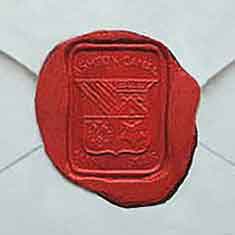
Seal of the Peak Forest Canal Company
The hawk (falcon) hovering above represents the Peak District of Derbyshire, the source of wealth. On the left of the seal, a winged classical figure, symbolic of patriotism (Britannia) or commerce (Minerva) or success (Victory),
is holding the rudder of a boat with her right hand while she takes fruits of the earth with her left hand from a cornucopia (horn of plenty), which is carried by the boat and supported by a cherub, symbolic of the
youthfulness of the enterprise. The boat is symbolic of the means of trading and the success of the navigation while the rudder is symbolic of steering a true and straight course through troubles to success.
Behind the classical figure, on the left, there is an urn with an abundance of water flowing from it to fill the navigation. Below the rudder, the spade is symbolic of the navigators (navvies), without whose labour the
navigation could not have been built.
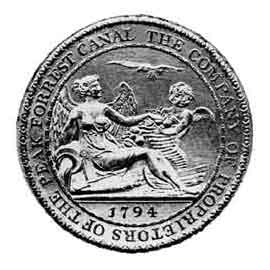
However, there is also a deeper meaning to some of the heraldic symbols used in this seal. The cherub represent dignity, glory and honour; a missionary; a bearer of joyful news. The hawk (falcon) represents one who does not rest until the objective is achieved. The cornucopia represent the bounty of nature's gifts. The fruit represents felicity and peace.
The seal is dated 1794 and around the periphery it is worded, THE COMPANY OF PROPRIETORS OF THE PEAK FORREST CANAL. It was engraved by John Carey at a cost of £5 0s 0d. It was in use from 28 Mar 1794 until 25 Mar 1846 at which time the company was leased to the Sheffield, Ashton-under-Lyne and Manchester Railway Company.
Seal of the Macclesfield Canal Company
This depicts a lion rampant holding a wheat garb (sheaf) taken from the Coat of Arms of the town of Macclesfield. This represents good harvests and the rural nature of the areas through which the canal passes.
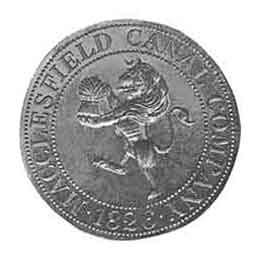
The deeper symbolism is that the lion rampant represents dauntless courage and the wheat garb is representative of the harvest of one's hopes having been secured.
The seal is dated 1826 and around the periphery it is worded, MACCLESFIELD CANAL COMPANY. It was in use from 11 Apr 1826 until 25 Mar 1846 at which time the company was leased to the Sheffield, Ashton-under-Lyne and Manchester Railway Company.
Sheffield, Ashton-under-Lyne and Manchester Railway Company
The three shields, from left to right, represent Sheffield, Ashton-under-Lyne and Manchester. The device above the shields depicts a white rose of Yorkshire within a red rose of Lancashire.
Around the periphery it is worded, SHEFFIELD ASHTON-UNDER-LYNE AND MANCHESTER.
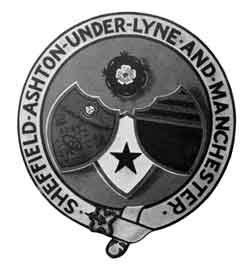
It was in use from 5 May 1837 until 1 Jan 1847 at which time it amalgamated with other companies to form the Manchester, Sheffield and Lincolnshire Railway Company. The Ashton, Peak Forest and Macclesfield Canals were collectively known as the Western Canal by the Manchester, Sheffield and Lincolnshire Railway Company.
James Meadows Junior, the Joint Principal Agent and General Manager of the Ashton and Peak Forest Canal Companies, was appointed as the Secretary of the Sheffield, Ashton-under-Lyne and Manchester Railway Company on the 1 Jan 1846. On the 25 Mar 1846, the Ashton, Peak Forest and Macclesfield Canals were leased to the Sheffield, Ashton-under-Lyne and Manchester Railway Company.
Share Certificate of the Sheffield, Ashton-under-Lyne and Manchester Railway Company
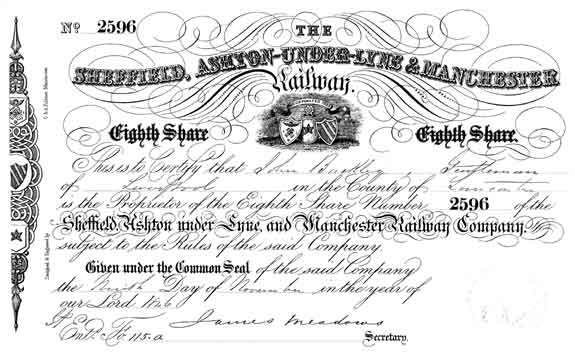
Manchester, Sheffield and Lincolnshire Railway Company
This is an early example and the central device depicts a rose, thistle and shamrock to represent Britain. Surrounding this are five devices, which are, clockwise from the top, a sailing ship
representing Manchester, arrows representing Sheffield, a fleur-de-lis mounted on a cross representing Lincoln, two rampant choughs representing Retford and a chevron and three boars representing Grimsby.
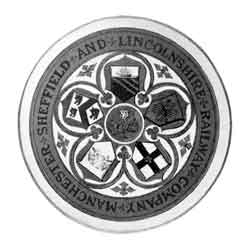
Retford is in the county of Nottinghamshire lying between Doncaster and Newark-on-Trent, the deeper symbolism of the choughs representing strategists in battle and being watchful for friends.
Other Coats of Arms of the Manchester, Sheffield and Lincolnshire Railway Company
The one on the left was in use until 1888 and around the periphery it is worded, MANCHESTER SHEFFIELD & LINCOLNSHIRE.
The one on the right was in use from 1888 until 1 Aug 1897 and around the periphery it is worded, MANCHESTER SHEFFIELD & LINCOLNSHIRE RAILWAY Co. At this time the name of the company was changed to the Great Central Railway Company. The opening of their railway line to London occasioned the change of company name, the new line being known as the 'London Extension'.
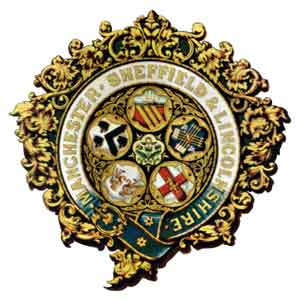
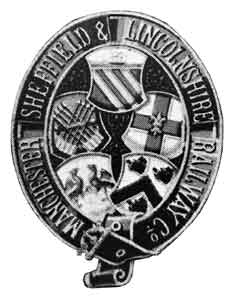
Seal of the Great Central Railway Company
The seal is a winged Pollitt locomotive. The upper section of the shield, from left to right, represents, Manchester, Sheffield and Lincoln and the two wings represent swiftness and protection.
The two daggers and cross represent London and the winged helmet at the centre of the cross represents Hermes. In Greek mythology, Hermes is the messenger and herald of the gods as well as being the
god of commerce, invention and cunning. Hermes is also identified with Mercury, the messenger of the Roman gods. Below the shield is the company motto, FORWARD. On either side of the shield, roses and
thistles represent Britain.
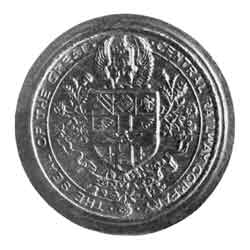
Around the periphery it is worded, THE SEAL OF THE GREAT CENTRAL RAILWAY COMPANY, and there is a Tudor rose at the bottom, this being symbolic of Lancashire and Yorkshire after the War of the Roses. Harry Pollitt was a widely respected locomotive engineer for the Great Central Railway Company and he should not be confused with Colonel Sir William Pollitt who was a director of the Great Central Railway Company and a Government official nor with the Harry Pollitt who was a Communist politician. For the record, Colonel Sir William Pollitt was the High Sheriff of Cheshire in 1908.
Great Central Railway Company
This has the same symbolism as the company seal with the company motto, FORWARD, below the shield.
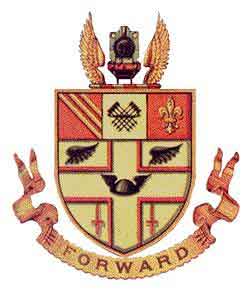
The House Magazine of the Great Central Railway Company was also called FORWARD.
Coat of Arms and Badge of the London and North Eastern Railway Company
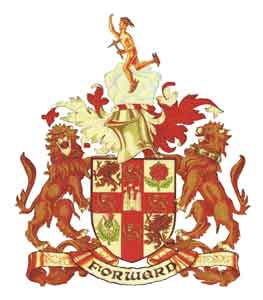
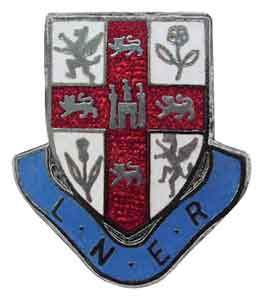
Overview of Changes in Ownership since 1 Jan 1847
The Manchester, Sheffield and Lincolnshire Railway Company leased the three companies that comprised their Western Canal from the 1 Jan 1847 until the 2 Aug 1863, on which day the railway company finally owned them.
The three canal companies then remained in existence until they were dissolved and vested in the railway company on the 2 Aug 1883. On the 1 Jan 1923 the Great Central Railway Company merged with
other companies to form the London and North Eastern Railway Company.
On the 1 Jan 1948, the London and North Eastern Railway Company, including its canals, was nationalised, along with all the other railway companies, to become part of the British Transport Commission. The nation's railway system then became known as British Railways. Simultaneously, all the canals formerly owned by railway companies came under the control of the Inland Waterways Division of the British Transport Commission who adopted the name, British Waterways Board. Subsequently, the name was changed to British Waterways. British Waterways has now ceased to exist in England and Wales and was replaced by a charity called the Canal & River Trust.
In this process of change, British Waterways, as a Non-Departmental Public Body (NDPB) usually referred to as a Quasi-Autonomous Non-Governmental Organisation (QUANGO), was mutualised as a charity in the civic society model that will receive annual government funding. In this capacity it is a Non-Governmental Organisation (NGO). In other words, British Waterways made a transition from a public corporation, overseen by the Department for Environment, Food and Rural Affairs (DEFRA), to a charitable body in England and Wales.
To achieve this, in May 2011, eight transition trustees were apointed to oversee the establishment of the Canal & River Trust that will take responsibility for the care of the historic waterways of England and Wales that were cared for by British Waterways. On the 11 Oct 2011 the Canal & River Trust was registered as Charitable Company Number 7807276. On the 4 Apr 2012 the Canal & River Trust was registered with the Charity Commission under Registration Number 1146792. This trust has a Board of Trustees, a Governing Council and HRH The Prince of Wales is the first Patron. From this date, the trust is legally permitted to raise charitable income in support of its objectives. On the 2 Jul 2012 the Canal & River Trust formally took over the work of British Waterways.
The three canals that comprised the Western Canal are now part of the Manchester and Pennine Waterways of the Canal & River Trust along with the Rochdale Canal, Huddersfield Narrow Canal, Manchester Bolton and Bury Canal and the Trent and Mersey Canal (from the south portal of Harecastle Tunnel).
Establishment of the Canal & River Trust on the 12 Jul 2012
More than 2,000 miles of historic canals and rivers across England and Wales were handed over to the Canal & River Trust in a move to get communities more involved in their local waterways.
The Canal & River Trust is the guardian of 2,000 miles of canal and river across England and Wales. The Trust, which is among the largest charities in the UK, has taken over from British Waterways and The Waterways Trust in England and Wales to become the guardian of the nation’s third largest collection of Listed structures, as well as museums, archives and hundreds of important wildlife habitats.
By giving people a greater role in the running of their local waterways, the Canal & River Trust marks the next chapter in the long history of the nation’s former industrial waterways. The move is underpinned by a £1bn investment from government, including a landmark 15-year grant funding agreement, and opens up the potential for attracting new sources of income.
Addendum
It is perhaps surprising that the Ashton, Peak Forest and Macclesfield Canal Companies survived for another 37 years after they were leased to the
Sheffield, Ashton-under-Lyne and Manchester Railway Company in 1846. To all intents and purposes, from 1846 onwards they were defunct as companies, as the day-to-day operation of the canals was then
entirely under railway company control. Nevertheless, they still had two important legal obligation to fulfil. The first was to be responsible for the payment of any dividends due to canal company shareholders at the
time that they were leased and who continued to hold them. The second was to be responsible for the payment of interest on any outstanding loans that were entered into prior to 1846.
By 1883 it can, therefore, be assumed that no canal company shareholders were then left and that all outstanding loans had been paid back in full.